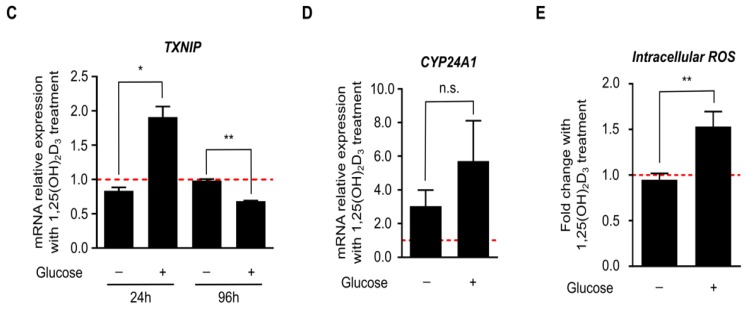Figure 3.
Regulation of TXNIP expression and redox balance in HL-60 cells by 1,25(OH)2D3 is glucose-dependent. (A,B) Immunoblots showing TXNIP protein levels. (A) In the absence of glucose, expression of TXNIP in HL-60 cells is significantly reduced, and appears to be unaffected by 1,25(OH)2D3 (100 nM) treatment. “+” and “−” denote the presence or absence of the indicated molecule/treatment, respectively; (B) In the presence of a single high dose of the glucose uptake inhibitor phloretin (200 µM), added at different time intervals prior to the end of the initial treatment period (24 h), 1,25(OH)2D3 is found to be incapable of inducing TXNIP expression; (C) Changes in TXNIP mRNA levels after 24 and 96 h of treatment with 1,25(OH)2D3 in HL-60 cells, cultured in the presence or absence of glucose, reveal that regulation by 1,25(OH)2D3 is glucose-dependent. The dashed red line indicates baseline mRNA expression in DMSO-treated cells set to 1. Error bars ± SD; n = 2; (D) Unlike TXNIP, the 1,25(OH)2D3 target gene CYP24A1, is induced in response to 1,25(OH)2D3 treatment (96 h) independent of glucose availability. Error bars ± SD; n = 2; (E) In absence of glucose, intracellular ROS levels are largely unaltered upon treatment of HL-60 cells for 96 h with 1,25(OH)2D3. The dashed red line indicates basal ROS levels in DMSO-treated cells set to 1. Statistical significance was calculated using a two-tailed Student’s t-test, with p-values less than or equal to 0.05 and 0.01 depicted by * and **, respectively. Nonsignificant results are denoted as n.s. Error bars ± SD; n = 3.


